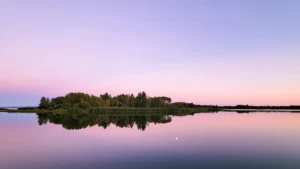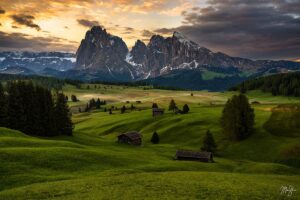If you’re a photographer, sooner or later you’ll ask yourself if you should set your camera to portrait or landscape orientation. You’re always making choices as a photographer, and this is an important choice to make because it really has to do with the composition of the photo.
In fact, you could argue this is one of the most important choices you’ll make when you’re shooting. Let’s start by getting our terms straight with the first difference.
1. Landscape vs. Portrait Mode: Horizontal vs. Vertical Orientation
The landscape orientation refers to horizontal subjects or a canvas wider than it is tall. Portrait format refers to a vertical orientation or a canvas taller than it is wide.
Landscape usually involves subjects that are too wide to shoot with a portrait orientation, so you have to turn the camera sideways and shoot horizontally. Portrait shots are vertically oriented, and as the name suggests, that’s the favored mode for shooting portraits.

2. Compositional Differences
When choosing between portrait and landscape formats, you have to decide what is better for the photo you’re trying to create.
Any scene can be captured with either orientation, so it’s up to you to decide. You should take the following into consideration:
- Subject — You usually want to fit the entire subject into the frame, and you want to do it in a visually interesting way. That means you have to make choices about what to include and what to exclude. Once you’ve made that choice, you can determine whether it would be better to shoot in portrait or landscape format.
- Scene — You’ll want to consider what’s in the background and how much of that you want to include in the image.
- Purpose — What’s the message you want to convey with the photo?
3. Background Elements
With portrait format, the vertical lines are more prominent. If the scene has a lot of vertical lines, you can either shoot in portrait format to make them appear never ending, or shoot in landscape format to crop them and make them feel more solid.
On the other hand, when there are a lot of horizontal lines in the scene, that gives a feeling of balance and security in the image. Shooting that scene with a portrait format cuts them off, and you remove some of that balance and secure feeling.
4. Space Differences
A big difference between landscape and portrait format is that landscapes are about space–they make you feel like there’s room to breathe. So, if they’re shot in landscape orientation, the image feels more spacious. The space created can give the image an entirely different feel. The same image shot in portrait mode can accentuate vertical subjects, making them seem more regal.

5. Difference in Focus
This refers to what you want the viewer to focus on in the image. Here again, it’s about choices. Step in closer, fill the frame with your subject, and give it a vertical orientation (portrait) to make your subject look tall and imposing. The focus is completely on the subject.
On the other hand, if you step back, include more background (i.e., provide more space in the image), and shoot in landscape format, suddenly the main subject becomes one piece of a larger puzzle.

6. Difference in Distance
When you’re shooting a photograph in portrait format, the viewer feels closer to the subject because it fills up more of the frame. On the other hand, shooting in landscape format gives the viewer the feeling of greater distance. The main subject seems further away because less of it fills the frame.
7. Difference in Emotional Impact
Portrait orientation can make the subject feel more imposing, even regal. And, because you’re closer, it can give the image more of an intimate feel. In contrast, using landscape mode can make the subject feel smaller, perhaps even vulnerable. But it could also provide context that would make it seem grander. Your choice depends in large part on the feel you’re trying to create, and that also depends on your subject.

8. Context Differences
Because you see more of the background with landscape mode, it provides a greater context for the subject in the image. That gives the viewer more information, whereas shooting in portrait mode removes context, making the subject more mysterious.
9. Dimensions
One big difference between portrait mode and landscape mode is the dimensions of the images. You might have a certain thing in mind stylistically, but your client might be taking the images for a specific purpose, and they might have strict dimension requirements. You should take that into consideration when arranging the composition for your photos.
10. Stylistic Differences
Here, for both landscape and portrait
If the subject’s lines lead your eye horizontally across the scene, for example, then shooting the photograph in portrait mode would cut those lines off and limit the effect. The opposite is true if the leading lines are vertical in nature.

11. The Rule of Thirds
This is an area where there’s no difference between portrait and landscape mode. You might think that you want to center the subject with portrait mode, but that’s not the case. In either orientation, if you put your subject in the center, you’ll probably have a photograph that is uninteresting.
You always want to use the rule of thirds, and that is a factor in considering whether to shoot in portrait or landscape mode. Depending on your scene, adjusting your composition in accordance with the rule of thirds might require one mode or the other.
What are the best subjects for each mode?
If your subject or scene is taller than it is wide, then it’s likely you’ll want to set your camera in portrait format. If it’s wider than it is tall, it’s likely landscape mode will work better. But these are not hard and fast rules. There are times when you might want to focus on a part of a scene that is wider than it is tall.
For example, if there are multiple tall features in a wide landscape scene, you might want to focus on a single feature and shoot it in portrait mode. Likewise, not all portraits are shot in portrait mode. Though that’s frequently the case, there are times when you might want to include more of the background with your subject, and in that case, landscape mode might be preferred.

In the end,

Do you want to emphasize the subject or put it into context? Are you looking to use space to create a sense of grandeur? Do the leading lines pull your eyes up into infinity? Is your subject imposing, almost regal? And, of course, if you’re shooting for a client, what are their requirements?
Your answers to those questions will determine whether it’s best to use portrait or landscape orientation. If you’re uncertain, don’t be afraid to experiment. Take the photos with your camera in both orientations and see what works best.
Frequently Asked Questions
What is the advantage of portrait orientation for portrait photography?
First, it focuses the viewer’s eye on your subject, and for portraits, that’s what you want. You can also minimize the influence of the background by, for example, blurring the background. That also emphasizes your subject, and this is usually the goal of portrait photography.
Should you use landscape with a closeup shot?
Most of the time, when you’re using landscape orientation, you’re trying to create a sense of space, but you can also use this orientation for close up photography. One example of when this might be appropriate is when you’re striving to create photographic art. This is why there are no hard and fast rules for when to use which orientation.

Which mode works best for the majority of pictures?
Some photographers advocate leaving your camera set in landscape mode because you can always crop the photo to bring more focus to your main subject. But it’s really always best to shoot the photograph in the mode that works best for your scene. You shouldn’t depend on cropping to perfect the photograph.
Why is portrait mode not always best for portraits?
When you want to get close to your subject’s face but want to offset it to one side, it’s better to set your camera in landscape mode, and this can create really dramatic effects. Another time when this works well is when you want to get an image of a tightly cropped face. You’ll likely lose a bit of the forehead and chin, but this orientation will give you a strong presence with the eyes prominently placed.









